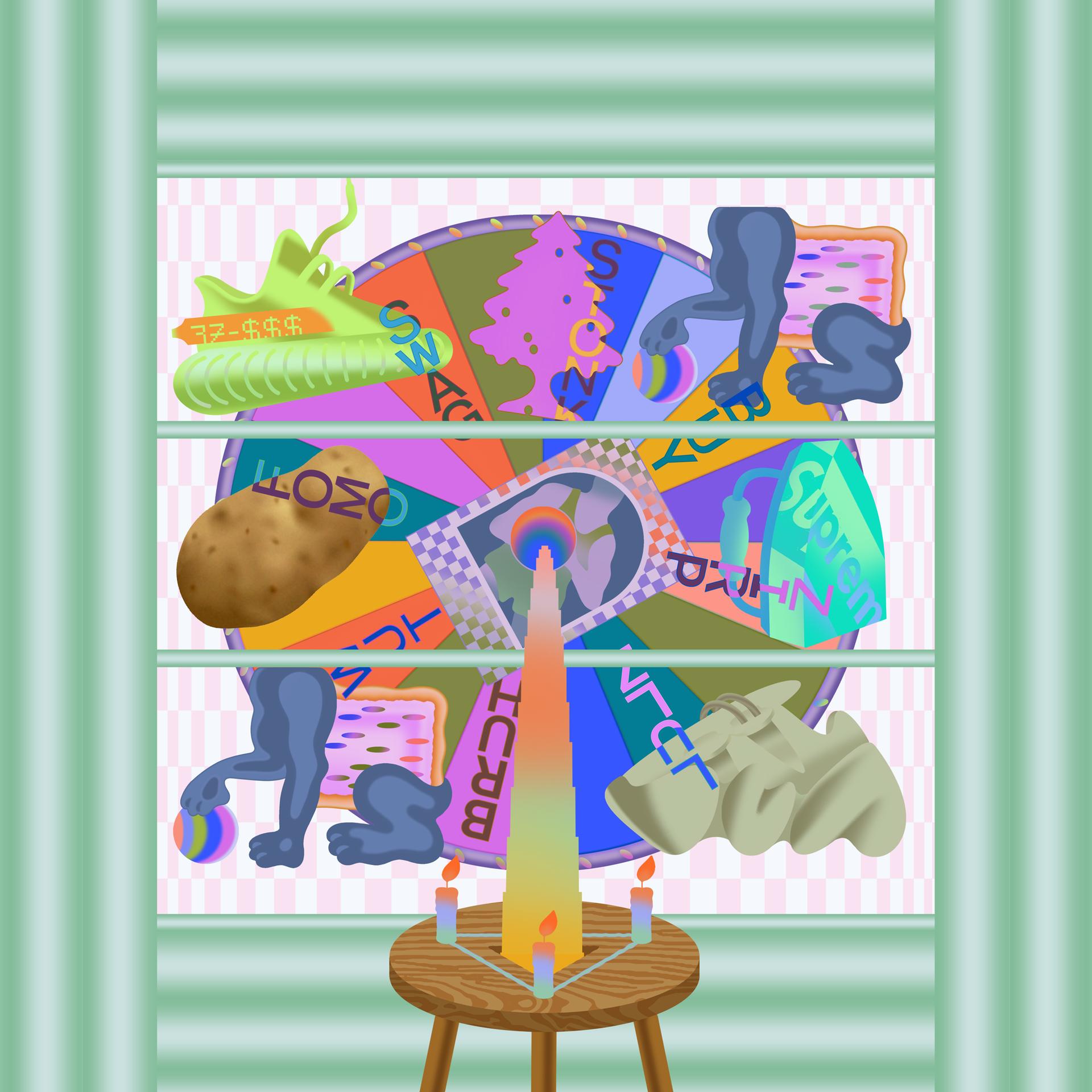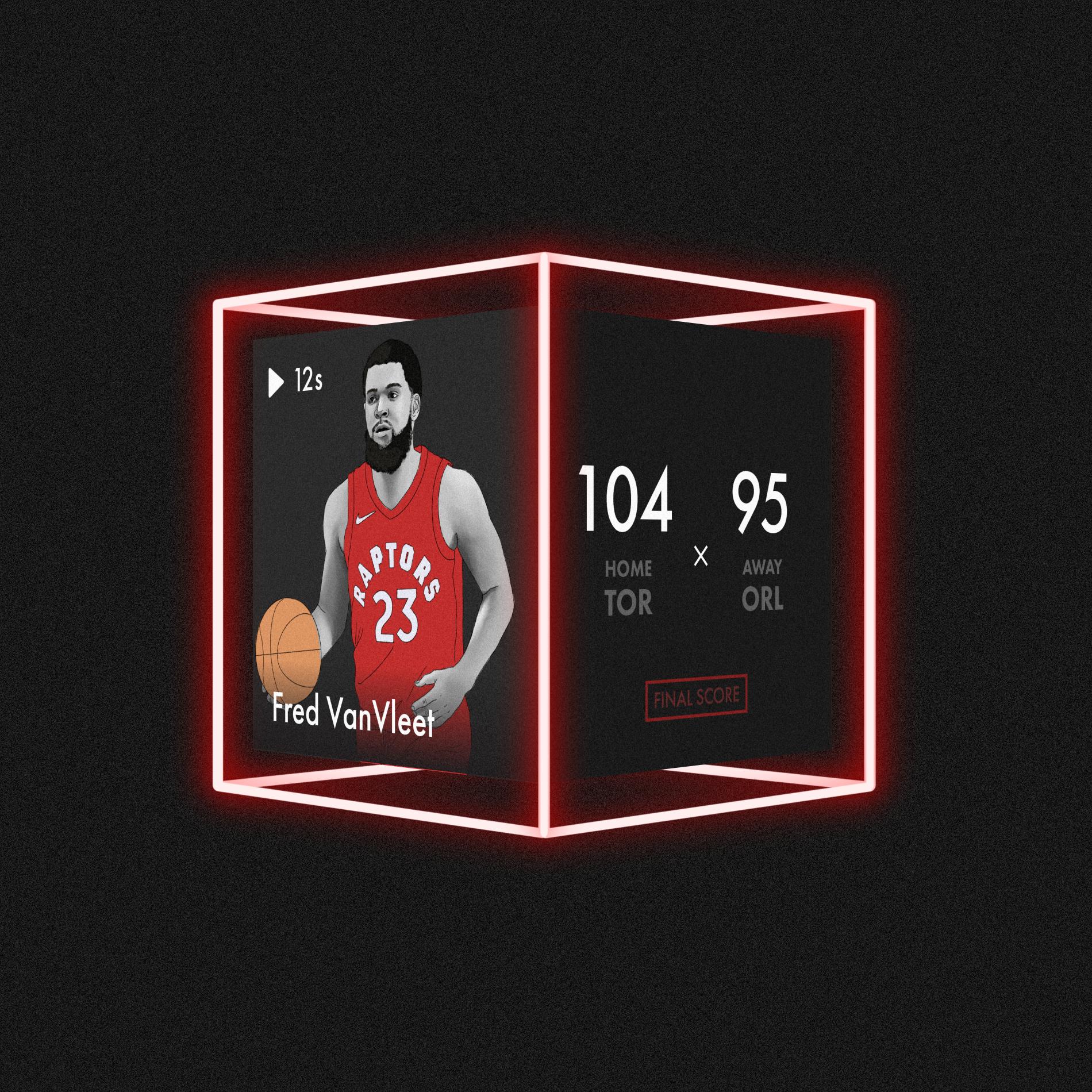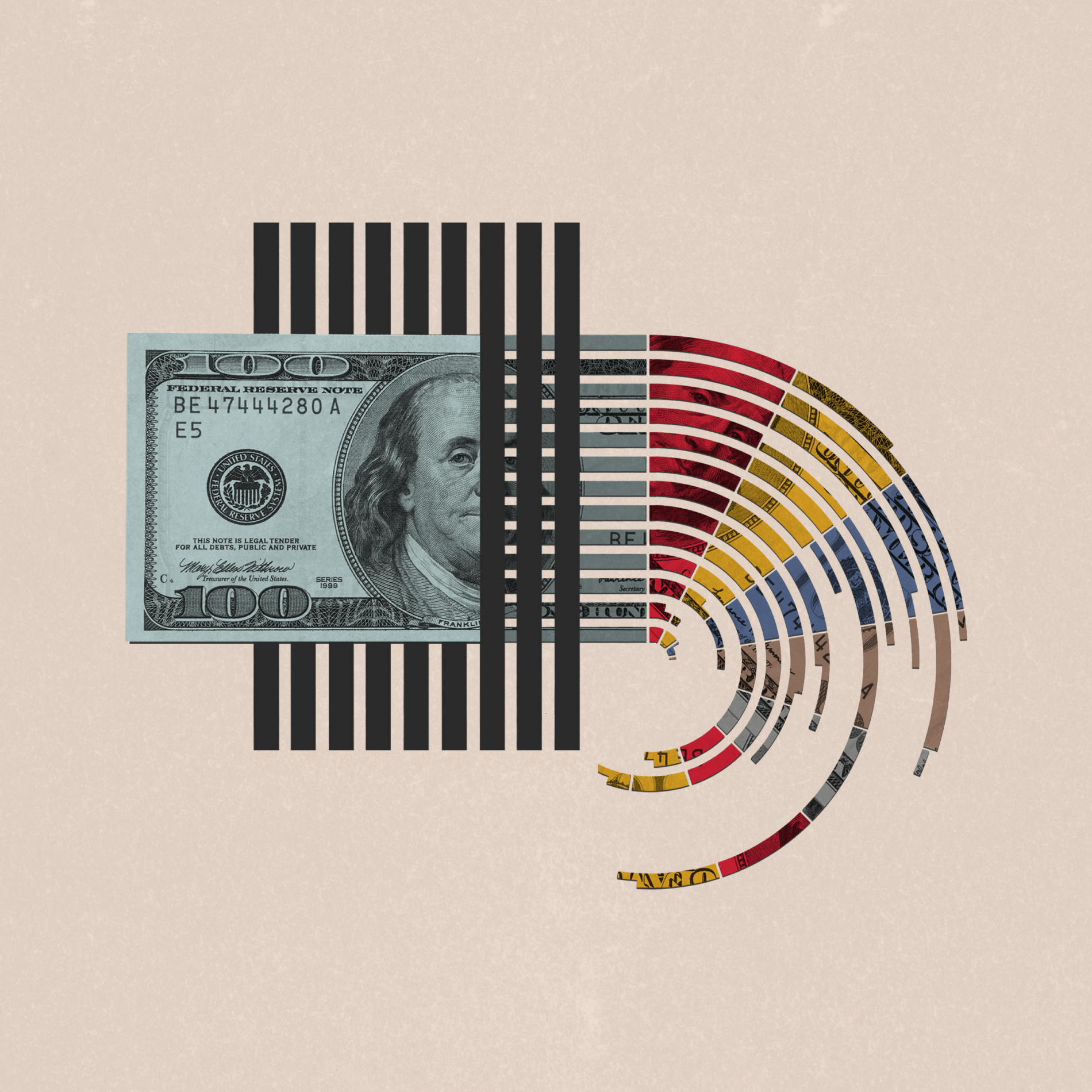
Money & the World
For a Shot at Cycling Glory, Amos Scott Bouris Just Needs Talent, a Little Luck, and $400,000
Canada’s youth-racing phenom hopes to compete in the toughest, most-prestigious international contests. But, as the writer Kate Wagner discovered, the path to becoming a world-class cyclist is as unclear as it is costly. In fact, it’s really, really expensive.
Wealthsimple makes powerful financial tools to help you grow and manage your money. Learn more
From around the corner, I can already hear it: the terrible soundtrack of bike racing. It’s a mix of buzzing rear-wheel hubs, chitchat, and Katy Perry’s “Teenage Dream” piped in through tinny speakers. Why every bike race has to play the worst pop hits from the worst era of pop music is beyond me, but it’s a fitting song, as the competitors are, in fact, teenagers. This gaggle of teens is here, in Saint-Georges, Quebec, for the time-trial portion of the Canadian Under-17 (U17) National Championships.
A career in elite cycling begins not on the sides of the Pyrenees mountains of France or Spain, but in places just like Saint-Georges, a small town an hour’s drive south of Quebec City, where the next generation of Canadian champions currently sits in folding chairs in a gravel parking lot, sandwiched between a field of wildflowers and a lackluster playground. Dozens of oversized trucks and hatchbacks are parked mirror to mirror, bikes dangling off the back. Parents stand around shooting the shit, while a few riders fiddle with their bikes, their kits, their sunscreen, their sunglasses. They chat with each other — it’s a small world. A young guy spins the back wheel of his bike, producing a loud whirring sound prized by cyclists. “Listen to that son of a bitch,” he says to his friends.

I’ve come to watch these young riders compete to get an inside look at what it takes to make the first steps towards being a top-tier cyclist in Canada. All the Canadian racers who step up to the starting line during the Paris Games were competing in small events just like this not too many years ago. For most young athletes, their competitive dreams will live and, most likely, die at small events like this one. Several thousand Canadian teens participate in competitive races each year, hoping to someday be among the tiny number of elite cyclists — 21 for this year’s Games — that represent Canada. And even the riders who reach this rarified club compete knowing that a large financial reward likely doesn’t await them.
This year, any Canadian athlete who takes gold will receive $25,000, courtesy of donations and a sponsor-backed fund. For silver, $20,000. Bronze: $15,000. Most Olympians spend far more money on training alone (to say nothing of gear, travel, food, etc.), which typically runs about $15,000 a year, according to the Canadian Olympic Committee. That can add up to nearly $200,000 over the dozen years many athletes spend mastering their sport. Personal endorsement deals tend to be modest for Canadian Olympians, which explains why some end up drowning in debt, as the Globe and Mail reported recently.
This year, any Canadian athlete who takes gold will receive $25,000. Most Olympians spend far more money on training alone.
The young riders in Saint-Georges have more immediate concerns than money, however. Today, they just want to win, and the stakes to do so couldn’t be higher. Each June, cyclists from around the world return to their home countries to compete for their national titles and placement on elite national teams. For Canadian riders, the stakes are amplified by the fact that cycling is not as popular in North America as it is in Europe, and, as a result, opportunities for young riders to advance are scant. Entire futures are on the line: the podium finishers of the time trial and road race in Saint-Georges secure an automatic place on the Canadian national team, which means the door is open for further successes — riding trips to Europe, higher-profile races, and perhaps even a career in cycling. To perform poorly likely means having to go back to local races; applying for (often-expensive) camps; and scrounging North America for other opportunities to compete.
Today’s event is the time trial, a test of a cyclist’s individual capacity for suffering. It’s a race against the clock, the fastest time wins. Without the camaraderie of a peloton, each rider is alone with their breath, their anxieties, and their willpower. It’s no wonder that when all the riders line up in front of a large tent flanked by barriers, they fall silent. It’s a strange scene. A time trial is all about aerodynamics, so the riders use spokeless disc wheels and wear teardrop-shaped helmets that belong on the set of Alien more than in any sport — anything to shave off a few seconds. A box trailer parked near a stormwater ditch serves as a start ramp. Among the riders waiting to begin is Amos Scott Bouris, a redheaded kid with a face bursting with freckles. He cups his helmet in his hands and stares at his distorted reflection in the visor. Katy Perry fades into the Black Eyed Peas’s “Let’s Get It Started.”
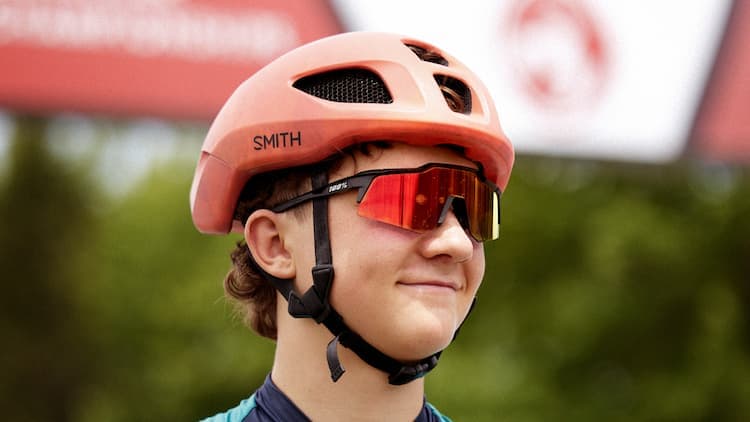
The music pauses briefly when an announcer reads off Amos’s name. He solemnly walks up the steps into the trailer, a lean Cervelo bike tucked under his arm. Amos, 16, is from the city of Victoria on Vancouver Island. He burst onto the scene earlier this year at the Canadian Track Championships, in Bromont, Quebec, where he podiumed eight out of ten races. In the points race — one of the hardest tests of stop-and-go endurance in cycling — he left as national champion, a feat that left no doubt that he’s among Canada’s most elite and promising young cyclists. He currently races for a small local outfit called Broad Street Cycles, but his dream is to become a professional cyclist.
The trouble for Amos is that he is not only from Canada, where cycling is a growing yet still-fringe sport, but from British Columbia, where cycling is not as well financially or structurally supported as it is in Quebec, the heart of the Canadian road-racing scene. Amos, moreover, belongs to a middle-class family, a distinct disadvantage in a sport that demands significant resources. And, last, he is a Type-1 diabetic, which means he must pay special attention to his insulin levels, nutrition, and energy management.
Before Amos starts his 28-kilometer sojourn, a race official squeezes his back tire between two legs so that he can clip into his pedals. Another official counts down with his fingers. Then, when the man makes a fist, Amos barrels down the ramp, around the corner, and into the distance. Two ranch-style houses mark the corner around which he, and the whomp whomp whomp sound of his disc wheel, disappears.
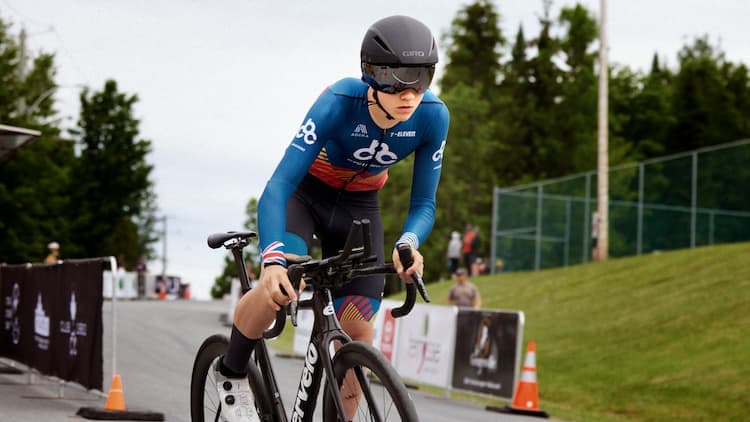
IF YOU ONLY watch the Tour de France, the impression you’ll get of cycling is that it’s a traveling circus of glory, pain, tactical maneuvering, and awe. Pelotons flash by sunflower fields in bursts of multicolored Lycra and climb mountain passes covered in snow, flanked by flag-waving fans. Then, at the finish line, a lone rider languishes on his bicycle, his pained face tilted toward the unforgiving sky. Grown men weep. Dreams come true. These are the moments that leave indelible marks on the young people who follow along at home. What is impossible to capture on TV is how daunting it is for aspiring riders to reach anything resembling these triumphant races, or how high the pressure has become for kids like Amos. The pressure is largely thanks to one man: Slovenia’s Tadej Pogačar, the world’s best racer. In 2019, Pogačar ushered in a new, higher-stakes era of cycling when, at the ripe age of 20, he podiumed in the Vuelta a España (Tour of Spain), before going on to win the Tour de France in 2020 and 2021. He won the Tour for a third time just days ago. Talent scouts have begun recruiting younger and younger riders in hopes of replicating Pogačar’s success, which raises the pressure on kids like Amos. But none hold this against Pogačar. His cheery personality and thrilling racing style — characterized by frequent, high-energy attacks and long, solo rides to the finish — have made him an idol to young fans and have helped to boost cycling’s popularity.
Cycling is enjoying a particular surge of interest in North America right now thanks to Pogačar and to the Netflix series Unchained, which follows the Tour. (It was reupped for a third season earlier this month.) Cycling has also benefited from the fact that North American racing is strong right now, thanks to American stars Sepp Kuss, Brandon McNulty, Nielson Powless, and Matteo Jorgenson, among others. Canada, too, has a star in Alison Jackson, who won the 2023 Paris-Roubaix race and who has become internet famous for her victory dances. She’ll be competing for Team Canada in Paris, as will Derek Gee, a must-watch Canadian who finished an impressive ninth on the Tour de France this year. All these big names mean more eyes on cycling and more interest in amateur- and youth-level riders, like Amos Scott Bouris.
Amos’s disposition is normally relaxed, aloof even. But whenever he talks about cycling, his eyes quiver with light, a light that anyone who has ever wanted something will recognize.
The course Amos is riding today leads past houses and fields and through a quiet world of pines. The route is “hilly, but not too steep,” explains a nervously waiting parent. This type of race is relatively new to Amos, who took up cycling competitively three years ago, at the relatively late age of 13. Before that, he competed in short-track speed skating, which he started at age four. “At a certain point in speed skating,” he tells me later when we talk. “You have to move to Calgary or whatever for high performance. So I decided to stop and focus on cycling.” He adds, “I found it more interesting than speed skating around in circles.” When he began watching cycling, he was immediately drawn to Pogačar, now 25, for his cavalier, versatile racing style. “He’s just such a fun rider to watch,” Amos explains.
Amos’s disposition is normally relaxed, aloof even, with a hint of teenage swagger. But whenever he talks about cycling, his eyes quiver with light, a light that anyone who has ever wanted something will recognize. For 16-year-olds and pro racers alike, the appeal of cycling is largely the same: it is a quest for self-betterment and self-understanding that takes place on a vast spatial and temporal scale. Races sometimes cover hundreds, if not thousands, of kilometres and involve up to three weeks of continuous competition. No other sport spans as much distance across as much varied terrain, or intersects with so much local culture, as cycling, nor does any other sport have as much high literary conflict. All in the same moment, a race is a struggle between man vs. man; man vs. machine; man vs. nature; and man vs. himself. The rider struggles on all fronts. That’s why watching cycling often highlights human beings’ capacity to overcome tremendous suffering, tremendous conflict, and somehow come away redeemed. Cycling is also, Amos tells me, just a lot of fun.
ONE OF THE main problems for a young rider like Amos is that the path from where he is now, racing in the under-17 level, to becoming a world-class cyclist is not obvious. Young French or Dutch riders know exactly what they need to do to advance, because the sport is culturally ingrained: at around eight years old, you join a kids’ team that’s usually part of a bigger, fully sponsored organization. Then you work your way up to the juniors (U19) and the under-23 level. And then — voila! — after more than a decade of racing, a talent agent picks you up and thrusts you into the big leagues. This trajectory is open to European children from across the wealth spectrum, since the teams provide riders with equipment, transportation, and whatever else they might need.
There is no such cycling machine for Canadian riders. There is currently one Canadian, Michael Leonard, on the WorldTour, the highest level of cycling. Six Canadian riders have spots in the ProContinental level, cycling’s farm league. Five of these riders are on Israel–Premier Tech, a team backed by Sylvan Adams, a Canadian–Israeli billionaire and real-estate mogul. Despite Adams’s support, spots are limited. So how do young riders make it onto a U23 team, much less to the semi-pro ProContinental level? If your parents have money, you travel to compete in the handful of competitive races held in North America each year and hope to get noticed. If your parents really have money, you move to Europe and try to lock in a spot on an international development team that’s a talent incubator for the WorldTour. One rider told this magazine that his family probably spent over $35,000 last year on international flights, race fees, and hotel accommodations, in addition to the cost of his road bike (about $15,000) and track bike ($20,000).
When I ask Amos’s dad, Ian, about the cost of even getting his son this far, he flinches. “I mean, as a family, we haven’t added it up,” he says. But it hasn’t been cheap.
Amos’s parents don’t have that kind of cash. His dad is an urban planner for a nonprofit developer; his mom works for the Department of Agriculture. Amos attends public school and works at a bike store, which gives him some equipment. He also gets discounts through his local team and area businesses. Still, his bike is a couple of years old, whereas racers from rich families sport models fit for the pros.
When I ask Amos’s dad, Ian, who traveled with Amos to Saint-Georges, about the cost of even getting his son this far, he flinches. “I mean, as a family, we haven’t added it up,” he says. But it hasn’t been cheap. Most Cycling Canada “projects” — or competitive-racing opportunities — “are almost all athlete-funded until you get to the super-high level,” he explains. He’s not trying to complain; they signed up for this as a family after all. “We’ve got sufficient money,” he adds. But not enough to move Amos to Europe. That means Amos, and any kid like him, will have to find a way to turn pro that doesn’t involve big organizations, big sponsors, or big money.
WAITING FOR AMOS to finish his race takes a long time. There is no video feed, so neither I nor anyone else has any idea how well he’s doing. When he’s halfway through, an official announces his time in unintelligible French: 20-something minutes? What’s clear is that he’s already well behind the current fastest rider, Jack Purdy, from Alberta. Ian, who’s wearing a province-appropriate T-shirt that bears the word “Poutine,” turns to me. “Well,” he says, “Amos mostly sees this race as training for the road race on Sunday.”
The comment has the shape of an excuse but isn’t one. Amos’s type of riding — bursts of hard effort followed by recovery — isn’t suited for time trials. But the rider that Amos is today isn’t necessarily the one he’ll be forever, as his coach, Holly Henry, explains to me later. When she and Amos started working together last November, “I could tell he was going to excel in whatever discipline he chose because he has that motivation,” she says. But, “being strong at 15 or 16 doesn’t necessarily mean [a rider is] going to be the strongest when they’re at their peak.” So, at Amos’s age, building talent means hard work and trying new things — road, track, time trialing, cyclocross. Guts help.
Eventually, a blue dot grows into a form. Amos is perched over his bike, his hands in the aerodynamic bars, close together as if in prayer. Sweat streaks his face as he digs in for a final climb, his bike teetering beneath him. I know the look well: he has overcooked it. The announcer nonchalantly announces his name as he crests the hill and crosses the finish line. He slows to a stop in front of his father and takes off his helmet. His face is sunburned, and his hair is plastered to his head with sweat. And he looks, well, a little sad. Ian wraps his arm around his shoulders.

An announcer reads off Amos’s time: 41 minutes 55 seconds. In the end, he finishes in eleventh place. As more riders bound out of the trailer, Amos, Ian, and I walk to a picnic bench. By the time we get there, Amos has brushed off the disappointment. He’s not thrilled about his performance, of course. “I just want to make the trips worth it,” he explains. But he says he’s more interested in the road race anyway, and today in no way dimmed his ambitions. “I want to be a professional cyclist someday as a job,” he tells me. “I want to go to the World Championships in Montreal in 2026.”
Ian looks at his son: “I don’t think the end goal is to become a pro cyclist.” He just wants Amos to enjoy himself and learn from the experience. He ticks through the opportunities that cycling could open up: college, working for a pro team, becoming a journalist. (I do not inform him of the dire financial straits of journalism.) Amos says nothing. Arms folded, he watches as the last of the riders yank themselves up to the finish line.
I HAVE SPENT a lot of time covering cycling: three Tours de France, two summers in Slovenia, plenty of week-long races. It’s hard to tell this to Amos — and maybe he doesn’t need to be told — but he is at the very last point where cycling can still be mostly pleasurable. He works hard, sure. He does group rides around Victoria on the weekends and has a fifteen-hour-a-week training regimen. He diets and does energy management. He competes throughout the year. But ultimately he is still doing kid cycling. That’s why he can place eleventh and remain in a pleasant mood.
Next, though, comes juniors, which is when cycling turns not very nice. Competition heats up. Fifteen hours a week becomes twenty, which becomes thirty. Teams run tests on promising riders, tests that are often uncomfortable and invasive, like riding with a respirator over your face to gauge your endurance. All of this is in hopes of landing a slot on a pro team, for a chance at a career. (And that career might be modest; some cyclists on the WorldTour make no more than $60,000 annually.) Juniors is the stage when most racers wash out, give up, and go home.
If all doesn’t go as planned this weekend for Amos, he needs an alternate route to gain access to the highest levels of cycling. One of his biggest advantages in that regard might be his diabetes. He recently contacted the Pro Team Novo Nordisk, which is sponsored by the Danish pharmaceutical giant. Everyone on the team has Type 1 diabetes, like Amos. This year, the team is putting on a camp in Tuscany, which it will use to find riders (aged 18 and older) for its pro and development teams. It also has a grant program for younger riders like Amos to join in. He plans to attend shortly after the race in Quebec. “All I have to do is pay for the plane ticket,” he says, beaming. The camp could be his way in. But before all that, he has one more shot here in the middle-of-nowhere Quebec.

THE ROAD RACE begins at 11 the next morning. The course runs 114 kilometers, another circuit through the rolling, rural hills of Saint-Georges. Amos kicks off with some of the best legs of his career. He escapes from the peloton in a group of 10 people, and he’s the only U17 rider among them. But then, at the last corner of the race, he crashes — running off the road into the dirt. “I was first of all the U17 riders, so I was fighting for that [national] jersey,” he explains to me on the phone when I’m back home in Chicago. “A guy slipped out in front of me, and I had nowhere to go,” he says. (I didn’t see the crash myself.) “I felt like I had a strong chance to sprint,” Amos explains. He had raced most of the other riders in his group before, and he felt sure he could sprint faster than any of them. But cycling is a cruel sport.
I can’t help but say, “I’m really sorry.” Because I am legitimately sorry. I want Amos to succeed in his improbable journey. He’s likable. He could be your kid brother or maybe your son. Fortunately for him, despite the crash, his journey is not over. Not yet anyway. He tells me about the camp in Tuscany, which he has already returned from, with almost breathless excitement. First, everyone completed some tests, which consisted of riding as hard as possible while various things were studied, such as the build up of lactate in the blood, which affects the feeling of pain and influences one’s endurance. It was, Amos says, “just like the pros.” The riders spent five and a half days on the road as team cars followed behind. “It was cool to experience, just for a week, what it was like to be a pro rider, to have the same support as them,” he says. The camp only made him want to pursue cycling even further, made his dream more real. Most important, it made him feel as if, for now, he still has somewhere to go. ♦
Kate Wagner is the architecture critic at The Nation and a contributor at the cycling publication Escape Collective. She lives in Chicago.
The content on this site is produced by Wealthsimple Media Inc. and is for informational purposes only. The content is not intended to be investment advice or any other kind of professional advice. Before taking any action based on this content you should consult a professional. We do not endorse any third parties referenced on this site. When you invest, your money is at risk and it is possible that you may lose some or all of your investment. Past performance is not a guarantee of future results. Historical returns, hypothetical returns, expected returns and images included in this content are for illustrative purposes only.

